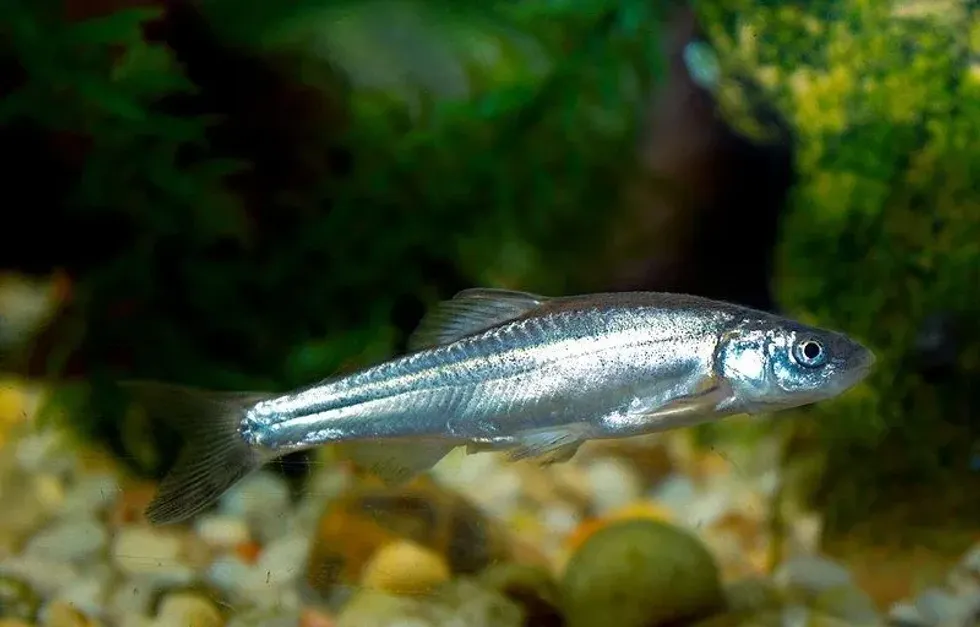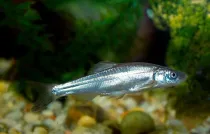The woundfin (Plagopterus argentissimus) is a species of fish, native to the Virgin River of Arizona. It is the one and only species of the genus Plagopterus.
With a tiny slender body, the woundfin has a long snout, flattened head, and belly. The skin is leathery and scaleless which shines in the water.
It is what makes it one of the favorites of human beings. The body length of the woundfin can range up to 3 in (7.6 cm). The habitat distribution range can be observed from the Colorado River with two tributaries to the Gila River.
The habitat of the woundfin includes warm and turbid waters of slower streams with a depth of about 8-18 in (20.3-45.7 cm). If proper care is not taken, their population status will go from Vulnerable to being listed as Endangered.
The silvery minnow is an omnivore. Due to its rarity, there is only a little information about behavior, communication, reproduction, and speed.
Many water development projects like dam construction and the introduction of invasive species in woundfin indigenous regions result in their population decline. To conserve the species, the woundfin introduced another river system but the spawning failed. Since they are Vulnerable species, a program was initiated for the eradication of the red shiner from the Virgin River.
This fish species have been dominating the native place of wounding by woundfin. Many fish barriers have been installed to restrict the expansion of the red shiner species.
To know more about fish species, read on, and you may also want to check out the leopard catfish and banjo catfish.
Woundfin Interesting Facts
What type of animal is a woundfin?
The woundfin (Plagopterus argentissimus) is a type of freshwater minnow fish and is the only species of genus Plagopterus.
What class of animal does a woundfin belong to?
The woundfin is a small endangered species that belongs to the class Actinopterygii, which is a ray-finned fish species.
How many woundfins are there in the world?
The woundfin population size is unclear.
Where does a woundfin live?
The woundfin distribution range can be seen from the intersection of the Verde Rivers and saltwater rivers of Arizona to the gate of the Gila River of Arizona. Its distribution extends to much of the lower Colorado River basin, and the two specific tributaries are known as the Gila River and the Virgin River in Utah, Arizona.
What is a woundfin's habitat?
The woundfin habitat includes extremely mineralized, muddy waters. It prefers highly turbid swift streams of warm water. The woundfin lives in salty streams and mostly avoids clean or freshwaters.
It can barely found in silent pools. Although, the immature woundfins like to live in slower and deeper water, whereas fry thrives in reverse water and stream that usually have algae growth on their borders. However, the egg-laying places have a swifter flow and sand substrates.
Who do woundfins live with?
There is no much information available regarding their solitary nature or group behavior, but during mating season the females join the group of males to spawn.
How long does a woundfin live?
The lifespan of the Plagopterus argentissimus ranges between two and three years.
How do they reproduce?
The knowledge about the reproduction of Plagopterus argentissimus is limited. The reproduction of these fish occurs once a year. The breeding season of the woundfin starts at the end of May.
The mating cycle is probably triggered by the rising temperature of the environment and lengthening daylight. The females of woundfin species leave their pools to find males in a prompt flowing stream.
After mating and depositing their eggs, females return to their original pools. The eggs of this endangered species are adhesive and generally, 0.05-0.07 in (1.5-2 mm) in diameter. Hatching occurs after four to five days.
What is their conservation status?
The woundfin lives near the bottom of the Colorado River, Virgin River, and Gila River of the southwestern United States. However, habitat destruction and water development or dam-building activities have led to the extinction of the woundfin species in these places as well as a drop in population in the Virgin River.
One more cause for being endangered is the introduction of new species, such as the red shiner (Cyprinella lutrensis) in these areas, which compete with the woundfin (Plagopterus argentissimus) for food. It also feeds on the eggs and juveniles of the woundfin fish.
Since 1970, this silvery minnow has been considered an endangered species. According to the IUCN, it is a Vulnerable species.
To conserve this endangered species, the New Mexico's Dexter National Fish Hatchery researched it and has spawned it in captivity, which is a major achievement.
Although, the transfer of these fishes into another river system has failed due to the non-occurrence of reproduction. In 2007, nearly 50 fish were introduced into the Hassayampa River of Arizona.
These were the hatchery-raised fishes collected from the Virgin River, the native place of woundfin. In the years 2007, thousands of captivity-raised woundfin were released in their indigenous regions.
Woundfin Fun Facts
What do woundfins look like?
The woundfin (Plagopterus argentissimus) is an endangered silvery millow, with a slender scaleless body, belly, flattened head, along with smooth, shiny scales on their body. The barbs are on the edges of the lips of fish.
It can grow up to 3 in (7.6 cm) in length. The presence of barbels distinguishes the woundfish species can be from the spikedace and spinedace species. The common name, woundfin, of Plagopterus argentissimus probably comes from the sharp-pointed spinous ray of the first dorsal fin.

*Please note this is an image of an ozark minnow, not a woundfin. If you have an image of a woundfin, let us know at hello@kidadl.com.
How cute are they?
The woundfin fishes look very cute due to their small size and reflective skin.
How do they communicate?
There is no information available regarding communication between woundfin species.
How big is a woundfin?
The woundfin size (Plagopterus argentissimus) is around 3 in (7.6 cm) in length, which is similar to the size of a clownfish.
How fast can a woundfin swim?
The swimming speed of woundfin has not been determined. However, it is believed that they have the same speed as small fishes like clownfish and mackerel.
How much does a woundfin weigh?
The weight of woundfin fish has been unidentified.
What are the male and female names of the species?
The male and female woundfin fishes have no specific names, separately.
What would you call a baby woundfin?
The baby woundfin (Plagopterus argentissimus) is generally known as larvae or offspring.
What do they eat?
As an omnivore, this silvery minnow fish feeds on algae, seeds, dead and decaying organic matter, insects, and their larvae.
Are they poisonous?
Woundfin is a small fish that does not possess any poison-producing gland. Therefore, it is a non-poisonous fish species.
Would they make a good pet?
The woundfin (Plagopterus argentissimus) is a famous aquarium fish. People keep it as a pet because of its leathery skin of silver color, which attracts individuals towards it.
Also, the diet of the fish is very simple. But they require special arrangements and care in captivity. For spawning, they need turbid water, appropriate temperature and pH, and an adequate amount of minerals and vitamins in freshwater.
Asthey are endangered in the USA, they are not allowed to be kept as pets but allowed in the UK as they are abundant in numbers.
Did you know...
The woundfin, also known as Plagopterus argentissimus is an endangered species that belongs to phylum Chordata.
Are woundfins endemic?
The woundfin is an endangered fish endemic to the Colorado River basin and its two tributaries in the southwestern United States.
Do humans eat them?
As woundfin is an endangered species, they are not able to be eaten by humans. Also, there is no data available regarding the woundfin as food.
Here at Kidadl, we have carefully created lots of interesting family-friendly animal facts for everyone to discover! Learn more about some other fishes from our giant frogfish facts and pigfish facts pages.
You can even occupy yourself at home by coloring in one of our Woundfin coloring pages.









